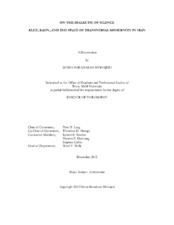| dc.description.abstract | This dissertation connects the cultural theory of space with specific aesthetic and architectural practices in the history of modernism that are entangled with the past and present of Iran, its artifacts, and its politics. As a response to different forms of alienation and despair symptomatic of Iran’s unfinished modernization plans throughout the twentieth century, this study reveals proposals for possible changes to the global ethics and language of space and Iran’s socio-cultural modernization through overlooked sources in this context: Paul Klee’s Miniature series (1916-1918) and Louis Kahn’s unrealized master plan for the New Civic Center in Tehran (1973-1974).
The first part of this study outlines the condition of globalism and its new coordinates with reference to the spatial theories of the later Heidegger and Deleuze. It then focuses on Klee’s narrative of spatiality as a result of his critical engagement with Persian miniatures. Through his Miniature series and the Twittering Machine, Klee maps an archeological analysis that identifies certain historical shifts in the Iranian discursive language of space, a shift into the machinic sensibility that poses a critique to pure “representation” and the hierarchical model of space. This dissertation further looks at Kahn’s proposal for the Tehran Civic Center that was the site of intense struggle between centers of power and culture in Iran. Kahn’s democratic layout for a modern urban space in the heart of the Iranian metropolis suggests an indirect resistance to “authority” in the form of a politicized and institutionalized culture and identity.
This analysis reveals the works of Klee and Kahn as silent, invisible practices: while Klee opts under the pressure of a rising nationalism to cover up his Persian sources, Kahn’s democratic blueprint is excluded and erased by a successive pseudo-developer. This study argues that these tragic encounters of modernity with cultural place are not signs of failure, but rather can be understood as political practices that form the promise of a new reality, a new ethos as the intensive globalism yet to come. Through an engagement with the later Heidegger, Deleuze, Klee, and Kahn, this dissertation offers the theory of “transversality” as a silent political and ethical attitude of modernity that encounters every place in its living conditions of multiplicity, simultaneity, and movement and within the real, contingent effects of identity, representation, and authority. | en |


